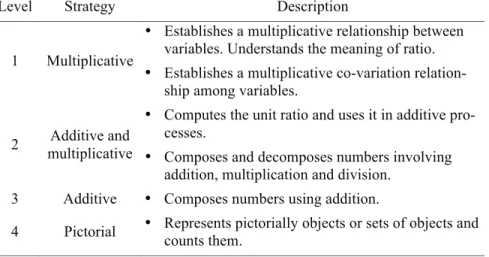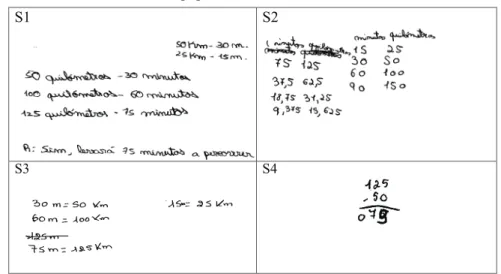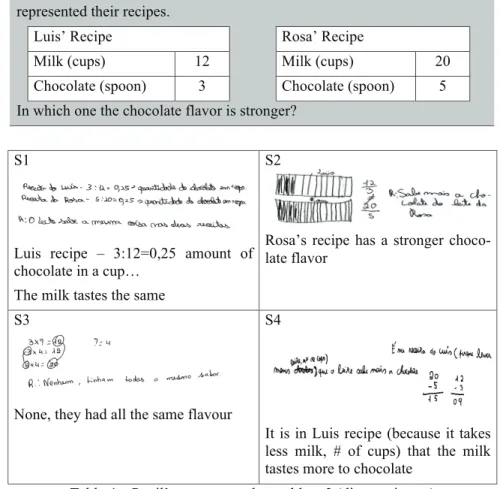4-185
PUPILS KNOW BEFORE THE TEACHING OF PROPORTION
Ana Isabel Silvestre Joo Pedro da Ponte Gaspar Correia School, Portugal Institute of Education
University of Lisbon; Portugal
This paper analyses grade 6 pupilsÕ mathematical processes and difficulties in solving proportion problems before the formal teaching of this topic. Using a qualitative methodology, we examine pupilsÕ thinking processes at four levels of performance in missing value and comparison problems proposed in a written test and in an oral interview video and audio recorded. The results show that pupils tend to use scalar composition and decomposition strategies in missing value problems and functional strategies in comparison problems. PupilsÕ difficulties are related to a lack of recognition of the multiplicative nature of proportion relationships.
INTRODUCTION
PupilsÕ ability in proportional reasoning is essential for their mathematical develop-ment. This reasoning is fundamental to solve daily life problems and also for learning advanced mathematical topics as well as other fields of study, including natural and social sciences (Post, Behr & Lesh, 1988). PupilsÕ difficulties in this aspect of mathematical reasoning are well known (Bowers, Nickerson & Kenehan, 2002; Van Dooren, De Bock, Hessels, Janssens & Verschaffel, 2005). Furthermore, as Lesh, Post and Behr (1988) note, there are many people that solve direct proportion prob-lems without using proportional reasoning.
The Portuguese mathematics syllabus indicates that pupils at grades 5-6 must understand the notion of proportion and develop proportional reasoning. This document points that pupils at grades 1-4 already work on mathematical tasks involving proportional relationships. In their planning, teachers must take into account such pupilsÕ prior informal knowledge. Thus, it is important to know pupilsÕ ability to solve proportion problems before the teaching of this topic. In this paper, we discuss pupilsÕ mathematical processes, including representations and strategies, in solving missing value and comparison problems, as well as their difficulties. Direct proportion
Proportional relationships may be investigated under different perspectives. In a psychological perspective, Vergnaud (1983) stresses the isomorphism of measures. In this model variables remain independent and the transformations within or between variables keep proportional relationships between numerical values (Figure 1).
1
Paper produced within Project IMLNA Ð Improving Mathematics Learning in Numbers and Algebra, supported by FCT Ð Fundao para a Cincia e Tecnologia, Portugal (contract PTDC/CED/65448/2006).
Figure 1: Isomorphism of measures model (Vergnaud, 1983)
In a mathematical perspective, a proportional relationship between two variables is represented as an equality of two ratios (a and c are values of a variable, b and
d values of another variable) or as a linear function y = mx with m 0. Finally, a
curriculum perspective stresses the use of representations, leading pupils to learn first to solve problems using equalities between ratios and then using linear functions. Generally, work with these two representations remains unconnected. Stanley, McGowan and Hull (2003) argue that the usual teaching approach for the development of proportional thinking in which pupils Òsolve proportionsÓ is outdated and should be replaced by another in which pupils engage in activities that help them discover that proportion is the variation of two quantities related to each other. Types of problems and pupilÕs strategies
Missing value problems present three numerical values and ask for the fourth value, whereas comparison problems present two or more pairs of numerical values and re-quest their comparison. Several studies identified pupilsÕ strategies in solving these problems. For example, Post, Behr and Lesh (1988) and Cramer, Post and Currier (1993) identified the following: (i) the ratio unit, the most intuitive strategy that pu-pils use since the early years of schooling (computation of ratio units on division problems and computation of multiple ratios in the multiplication unit), (ii) factor or factor of change scale (Hart, 1984), known as Òoften likeÓ strategy that is related to the numerical aspects of the problems but is used by many children, (iii) comparison of ratio problems associated with comparison, which allows comparing ratio units through two divisions, and (iv) cross product algorithm, also known as Òrule of threeÓ, which, while effective, is a mechanical process devoid of meaning in the con-text of the problems. In addition, Post, Behr and Lesh (1988) identified the strategy of graphic interpretation. Another rather informal strategy, that appears both in addi-tive and multiplicaaddi-tive reasoning, is composition/decomposition (Christou & Philip-pou, 2002; Hart, 1984). Lamon (1993) classifies reasoning strategies as ÒwithinÓ and ÒbetweenÓ variables, distinguishing between scalar reasoning (concerning the trans-formations within the same variable) and functional reasoning (establishing relation-ships between variables). In her view, the distinction between these two types of rela-tionships is important because they involve different cognitive processes.
METHODOLOGY
This study follows a qualitative approach (Denzin & Lincoln, 1998). The participants are four grade 6 pupils, both 11 years old, belonging to two different classes. Before the proportion chapter, all pupils in these two classes took a diagnostic test on the
topic. In each class, it was selected a pupil with satisfactory performance and another with difficulties in solving problems. Semi-structured interviews were conducted with these four pupils, video and audio recorded. Based on the strategies for solving proportional problems identified in the literature, we created a system of categories of analysis (Table 1). This repertoire of strategies was complemented by a pictorial strategy that was detected in this study.
Level Strategy Description
1 Multiplicative
Establishes a multiplicative relationship between variables. Understands the meaning of ratio. Establishes a multiplicative co-variation
relation-ship among variables.
2 Additive and multiplicative
Computes the unit ratio and uses it in additive pro-cesses.
Composes and decomposes numbers involving addition, multiplication and division.
3 Additive Composes numbers using addition.
4 Pictorial Represents pictorially objects or sets of objects and counts them.
Table 1: Categories of analysis for pupilsÕ strategies
RESULTS
Solving missing value problems
Margarida bought three books from the collection ÒOnce upon a timeÓ for 12 euro. If Margarida has 48 euro, how many books she can buy?
This problem, posed in an interview, has a simple context and its data involves multi-ples of 3. These are some of the pupilsÕ answers:
S1 said: Ò1 book costs 4 . If 10 books is 40 more 2 (8 ) is 12 books. Answer: She can buy 12 books.Ó
1 I: How did you think?
2 S2: I multiplied by 2. It is the double. (É) I think that this way will not do. (...) 48 euro, is here. (Points between 36 and 72.) 1 S3: 4 euro is one book, right? (...) I do 48 divided by 4 [euro] of
[books]. 44 [euro] is 11 [books]. 48 [euro] is 12 [books]. She can buy 12 books.
1 S3: IÕll do 3 on 3 [books] until it gives?
Table 2 Ð PupilÕs answers to problem 1 (interview)
S1, S3 and S4 give correct answers. S1 calculates the unit ratio she but does not use this functional relationship to determine the missing value, choosing to compose nu-merical values, as ten times, the double and their sum. S2 uses a composition strategy which involves the successive computation of the doubles of the numerical pairs. Us-ing this strategy, she cannot find the missUs-ing value. S3 develops a multiplicative functional strategy, using the price of each book, computing mentally the missing value (12 books), starting with a reference value (40 euro correspond to 10 books). Finally, S4 uses a strategy which involves the pictorial representation of the books and the successive addition of the price of 3 books until 48 euro, providing the miss-ing value (12 books).
A car takes 30 minutes to go 50 miles. At the same speed, how long it takes to go 125 miles?
This question of the diagnostic test has a simple context and data that involve multi-ples of 5. Here are some of the pupilsÕ answers.
S1 S2
S3 S4
Table 3 Ð PupilÕs answers to problem 2 (diagnostic test)
S1 determines the missing value using numerical composition/decomposition strat-egy. However, her written record does not allow us to understand if the numerical composition/decomposition involves additive or multiplicative reasoning. To obtain
the values 100 km and 60 minutes, respectively, the pupil may have done: (i) the ad-ditions 50+50 and 30+30; or (ii) the multiplications 2X50 and 2X30. Then, she may have decomposed the initial values, building a new representation in columns (upper right corner). The numerical values that are written by S1 on the third row of her first table seem to come from the addition of the numerical values of the second lines of the two representations, 125km=25km+100km and 75min=15min+60min. S2 and S3 answered in a similar way. S4 answered incorrectly computing the difference be-tween the distances as the value of the travelling distance (missing value).
Solving comparison problems
A comparison problem proposed on the diagnostic test has a simple context and the values of one variable are multiples of the values of the other variable. The pupilsÕ answer is shown on Table 4.
Luis and Rosa will do chocolate shake for brothers and cousins. The tables represented their recipes.
LuisÕ Recipe RosaÕ Recipe
Milk (cups) 12 Milk (cups) 20
Chocolate (spoon) 3 Chocolate (spoon) 5 In which one the chocolate flavor is stronger?
S1
Luis recipe Ð 3:12=0,25 amount of chocolate in a cupÉ
The milk tastes the same
S2
RosaÕs recipe has a stronger choco-late flavor
S3
None, they had all the same flavour S4
It is in Luis recipe (because it takes less milk, # of cups) that the milk tastes more to chocolate
S1 and S3 answer correctly. S1 represents the data as a division Ð using the symbol Ò:Ó Ð and computes the missing value. This is a functional strategy because it in-volves the relationship between the two variables. It shows the pupil understands the meaning of the invariant (0,25) which she does not yet see as the proportion constant but that she uses to make a qualitative judgement about the flavour of the mixtures. S3 begins by representing part of the data by an equation (3x?=12). Then he becomes involved on the exploration of the relationship between the quantity of chocolate and the quantity of milk, and he seems to have obtained mentally the invariant factor that he uses to judge the flavour of the mixture. This is a functional strategy. S2 and S4 answer incorrectly. S2 makes an incorrect pictorial representation of the data, be-cause it is not a whole:part relationship but a part:part relationship. Then, he writes another representation (a fraction) that does not correspond to the pictorial represen-tation. It is based on this representation that she says that RosaÕs mixture has a stronger taste of chocolate. S4 establishes a relation based on subtracting the quanti-ties of milk and chocolate.
The next problem shows a mixture of liquids, on a simple context, involving small numbers. The pupilsÕ answers are shown on Table 5.
At artÕs class, Ins and Maria joined black ink (black square) with white paint (white square) to prepare gray ink. Which girl prepared the darker gray ink?
1 S1: ItÕs like thereÕs only one in black... (Make the next record. Corresponds to two attempts.)
1 S2: ItÕs the same colour. 2 I: The grey is similar?
3 S2: It is... Or not? This [Maria mix] has more one [cup] white. It has the same black, it is equal.
1 S3: It is this one [Ins mix] because MariaÕs ink has more white, is clearer.
1 S4: I donÕt know... Well... (Points to MariaÕs mix) This has more ink? And... It has the same quantity of black ink... But which is more gray... I have no idea!
S3 answers correctly because he establishes a comparison between the mixtures at-tending to the quantities of white and black ink, knowing that the darker mixture is the one with less white ink. S1 and S2 answer wrongly saying that the colour of the mixtures is equal, arguing that they have the same amount of black ink, which means they are using only a part of the information they were given. However, S1 seems to be focused on the amount of black ink, because with her representations (InsÕs mix-ture) she tries to find the exact quantity of white ink that Maria used. S4 says that he does not know which of the mixtures is the darkest and shows that he is thinking about the total amount quantities of ink instead of the tone.
CONCLUSION
The results show that the pupils tend to solve correctly missing value problems using composition/decomposition strategies involving additive and multiplicative relation-ships at the same time. They tend to calculate doubles of the initial and intermediate values, getting more accurate values, as the solutions of problem 2 show. Then, they decompose the initial values on halves and find the missing value using addition. We may think that this strategy involves specific relationships using halves, as in prob-lem 2 (two and a half times). However, pupils also use this strategy in relationships involving integer numbers. This is what happens in S1Õs solution to problem 1, where she uses reference values that she knows well, obtained by multiplication, and gets the missing value through addition. PupilsÕ use of composition/decomposition strate-gies face a difficulty when it is not possible to determine the missing value by nu-merical composition through doubling. In fact, in problem 1, S2 could not use other knowledge to find the missing value. Another difficulty involves the lack of under-standing that the difference between the given values of a variable does not corre-spond to the numerical value of the other variable.
On comparison problems, pupils show different performances, with more difficulties on the problem that involves the tone of the color. It is likely that they never had to think deeply about this situation, and they focus their attention on data in a partial way, despite the fact that the operations described on the problem are simple to carry out on an art class. On the problem about chocolate flavor, pupils tend to use a func-tional strategy. The representation of the relation between the values of the variables involves the ratio, indicated by Ò:Ó, but also the use of numerical columns where pu-pils explore the multiplicative relationship. One pupil reveals that he is able to ex-plain the meaning of the constant of proportionality in this problem. The difficulties identified relate to interpreting the part:part relationship as a part:whole relationship as well as using different representations of the relationship part:whole. Another dif-ficulty concerns the lack of understanding of the multiplicative relationship, estab-lishing incorrectly additive relationships between the variables.
We suggest that the pupils, before the formal teaching of direct proportion, tend to solve missing value problems using strategies that involve simultaneously addition and multiplication, and it is possible to identify rudimentary strategies that involve
pictorial elements and unitary count. On comparison problems, pupils are able to use multiplicative functional strategies. However, correct answers depend on pupilsÕ comprehension of the representations, of the nature of the relationship between the variables and of the context described in the problem.
This knowledge about grade 6 pupilÕs mathematical processes and difficulties in solving proportion problems, before its formal teaching, is important to teachers as it allows them to help pupils to develop proportional reasoning from their prior knowl-edge. On the one hand, teachers may promote the sophistication of pupilÕs strategies. For instance, composition/decomposition strategies may evolve and become scalar multiplicative strategies, reinforcing the comprehension of the multiplicative nature of proportions. On the other hand, knowing the difficulties and helping to identify the concepts that are not well understood and may lead to poor pupil performance, pro-vide teachers with hints about the work they need to propose to their pupils.
References
Bowers, J., Nickerson, S., & Kenehan, G. (2002). Using technology to teach concepts of speed. In B. Litwiller & G. Bright (Eds.) Making sense of fractions, ratios and
propor-tions (pp. 176-187). Reston, VA: NCTM.
Cramer, K., Post, T., & Currier, S. (1993). Learning and teaching ratio and proportion:
Research implications. http://education.umn.edu/rationalnumberproject /93_4.html
Christou, C., & Philippou, G. (2002). Mapping and development of intuitive proportional thinking. Journal of Mathematical Behavior, 20, 321-336.
Denzin, N. K., & Lincoln, Y. S. (1994). Introduction: Entering the field of qualitative re-search. In N. K. Denzin & Y. S. Lincoln (Eds.), Handbook of qualitative research (pp. 1-17). London: Sage.
Hart, K., (1984) Ratio: ChildrenÕs strategies and errors. London: NFER Nelson.
Lamon, S. (1993). Ratio and proportion: Connecting content and childrenÕs thinking.
Jour-nal for Research in Mathematics Education, 24, 41-61.
Lesh, R., Post, T., & Behr, M. (1988). Proportional reasoning. In M. Behr & J. Hiebert (Eds.), Number concepts and operations for the middle grades (pp. 93-118) Hillsdale, NJ: Lawrence Erlbaum.
Post, T., Behr, M., & Lesh, R. (1988). Proportionality and the development of prealgebra understandings In Algebraic concepts in the curriculum K-12. Reston, VA: NCTM. Stanley, D., McGowan, D., & Hull, S. H. (2003). Pitfalls of over-reliance on cross
multipli-cation as a method to find missing values. Texas Mathematics Teacher, 11, 9-11. Van Dooren, W., De Bock, D., Hessels, A., Janssens, D., & Verschaffel, L. (2005). Not
eve-rything is proportional: Effects of age and problem type on propensities for overgenerali-zation. Cognition and Instruction, 23(1), 57-86.
Vergnaud, G. (1983). Multiplicative structures. In R. Lesh & M. Landau (Eds.) Acquisition


